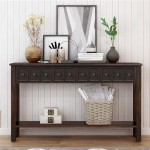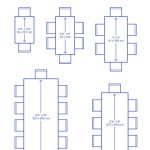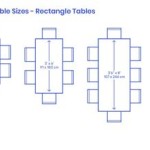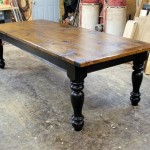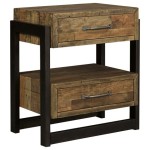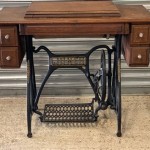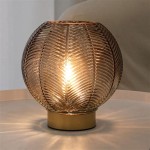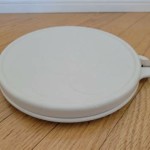The Allure and Practicality of an 11-Foot Dining Room Table
An 11-foot dining room table represents a significant investment and a deliberate choice to prioritize space for gathering and entertaining. Its sheer size commands attention and transforms any dining room into a focal point. While not suitable for every home, an 11-foot table offers a unique blend of functionality and aesthetic appeal, capable of accommodating large families, hosting elaborate dinner parties, and becoming a cherished heirloom for generations to come. This article will explore the considerations surrounding the acquisition and integration of such a substantial piece of furniture into a home, covering topics from spatial requirements to material choices and design considerations.
Spatial Requirements and Room Compatibility
Before even considering the design or material of an 11-foot dining room table, the most critical factor is the available space. An 11-foot table, measuring approximately 132 inches in length, demands a room that can not only house the table itself but also provide adequate clearance for comfortable movement around it. A general rule of thumb is to allow at least 36 inches of space between the edge of the table and any walls or other furniture. This allows for easy passage, comfortable seating, and prevents a feeling of being cramped. For an 11-foot table, this means the dining room should ideally be at least 17 to 18 feet long and wide to maintain a sense of balance and spaciousness.
Beyond the minimum clearance, consider the existing architectural features of the room. Low-hanging chandeliers or built-in cabinets can impact the layout and usability of the space. The shape of the room is also a critical factor. A long, narrow room might not be suitable for an 11-foot table, as it could create a claustrophobic effect. A square or rectangular room with generous dimensions is typically the most conducive to accommodating such a large piece of furniture. Visualizing the table in the room is crucial. Using painter’s tape to mark out the dimensions on the floor can provide a realistic sense of the table’s footprint and help determine if the space is truly adequate.
Furthermore, consider how the dining room connects to other areas of the home. A small doorway leading into the dining room could create a bottleneck, making it difficult to maneuver around the table. Open-plan layouts can be more accommodating, as they provide a seamless transition between the dining area and other living spaces. However, in an open-plan setting, it is important to define the dining area visually, perhaps with a rug or strategic placement of furniture, to create a sense of enclosure and purpose.
Material Choices and Durability
The material selection for an 11-foot dining room table is paramount, influencing not only its aesthetic appeal but also its durability, maintenance requirements, and overall cost. Hardwoods such as oak, maple, walnut, and cherry are popular choices for their strength, beauty, and longevity. Oak is known for its pronounced grain pattern and resistance to wear and tear, making it a suitable choice for families with children. Maple offers a smoother, more uniform surface and can be stained to achieve a variety of finishes. Walnut is prized for its rich, dark color and sophisticated appearance. Cherry is another beautiful hardwood that develops a deeper, richer hue over time.
The construction method is just as important as the type of wood. Solid wood construction, where the table is made entirely of hardwood, is generally considered the most durable and long-lasting option. However, solid wood can be susceptible to warping and cracking in environments with fluctuating humidity levels. Engineered wood products, such as plywood or medium-density fiberboard (MDF), can offer greater stability in such conditions. These materials are often used in combination with a hardwood veneer, providing the look and feel of solid wood without the same susceptibility to moisture-related issues. The type of finish applied to the wood also plays a crucial role in its durability and resistance to stains and scratches. A high-quality varnish or lacquer finish can provide excellent protection, while an oiled finish offers a more natural look and feel but requires more frequent maintenance.
Beyond wood, other materials can be incorporated into the design of an 11-foot dining room table. Metal accents, such as steel or iron legs, can add a contemporary touch and provide structural support. Glass tabletops offer a sleek and modern aesthetic, but they can be prone to scratches and require careful handling. Stone tabletops, such as marble or granite, are incredibly durable and offer a luxurious feel, but they are also very heavy and can be susceptible to staining. Ultimately, the choice of material should be based on a balance of aesthetic preferences, budget considerations, and practical concerns about durability and maintenance.
Design Considerations and Style Integration
An 11-foot dining room table is a statement piece, and its design should complement the overall aesthetic of the home. The style of the table should reflect the homeowner's personal preferences and the existing décor of the dining room. For traditional homes, a classic rectangular table with ornate carvings and a rich wood finish might be a suitable choice. A modern home might benefit from a sleek, minimalist table with clean lines and a simple metal base. Industrial-style homes could incorporate a table with a reclaimed wood top and sturdy metal legs.
The shape of the table is another important design consideration. While rectangular tables are the most common, oval or boat-shaped tables can offer a more intimate and conversational seating arrangement. A round table, though less common at this size, can create a sense of equality among diners and is well-suited for smaller gatherings. The height of the table is also important. Standard dining table height is typically around 30 inches, but this can be adjusted slightly to accommodate specific seating preferences or architectural features. It is critical to ensure the table height is compatible with the chosen dining chairs to provide a comfortable dining experience.
The chairs selected to accompany the 11-foot dining room table should not only be comfortable but also visually harmonious with the table and the overall design of the room. Consider the style, material, and color of the chairs to create a cohesive look. Upholstered chairs can add a touch of luxury and comfort, while wooden chairs offer a more classic and timeless appeal. The number of chairs needed will depend on the size of the table and the desired seating capacity. For an 11-foot table, at least 10 to 12 chairs are typically required. The arrangement of the chairs around the table is also important. Evenly spaced chairs create a balanced and symmetrical look, while a more asymmetrical arrangement can add a touch of visual interest.
Lighting plays a crucial role in enhancing the ambiance of the dining room and highlighting the beauty of the table. A statement chandelier suspended above the table can serve as a focal point and provide ample illumination. Recessed lighting can provide ambient lighting and highlight architectural features. Table lamps or sconces can add a warm and inviting glow. The color temperature of the lighting is also important. Warm lighting creates a more intimate and relaxing atmosphere, while cool lighting is better suited for task lighting. The placement of the lighting fixtures should be carefully considered to avoid glare or shadows on the table.
Finally, consider incorporating decorative elements to personalize the dining room and create a welcoming atmosphere. A centerpiece on the table can add a touch of elegance and visual interest. Vases of flowers, candles, or decorative bowls are all excellent options. A rug placed underneath the table can define the dining area and add warmth and texture. Artwork on the walls can enhance the overall aesthetic of the room and reflect the homeowner's personal style. By paying attention to these design details, an 11-foot dining room table can become a true centerpiece of the home, creating a space for memorable gatherings and cherished moments.
The acquisition of an 11-foot dining room table is a significant undertaking that requires careful planning and consideration. However, the rewards are substantial. This large table becomes a focal point, providing ample space for gathering, dining, and creating lasting memories. By carefully considering spatial requirements, material choices, and design considerations, homeowners can integrate an 11-foot table seamlessly into their home, transforming their dining room into a space of beauty and functionality.

Massive Large Farmhouse Table Long 10 Foot 11 12 13 14 All Sizes Stains Etsy

Farm Style Table 11 Chic Antique

Antique 11 Ft Flame Ref No 08988a Regent Antiques

Led Lit Live Edge River 11 Foot Dining Room Table

Led Lit Live Edge River 11 Foot Dining Room Table

Led Lit Live Edge River 11 Foot Dining Room Table

Full Circle Dining Table 11 Foot Diameter Imperial Gold And Crystal Chandelier Glass Top Royal Luxury Events

Led Lit Live Edge River 11 Foot Dining Room Table

Led Lit Live Edge River 11 Foot Dining Room Table

Antique 11ft Extending Ref No A3846a Regent Antiques

